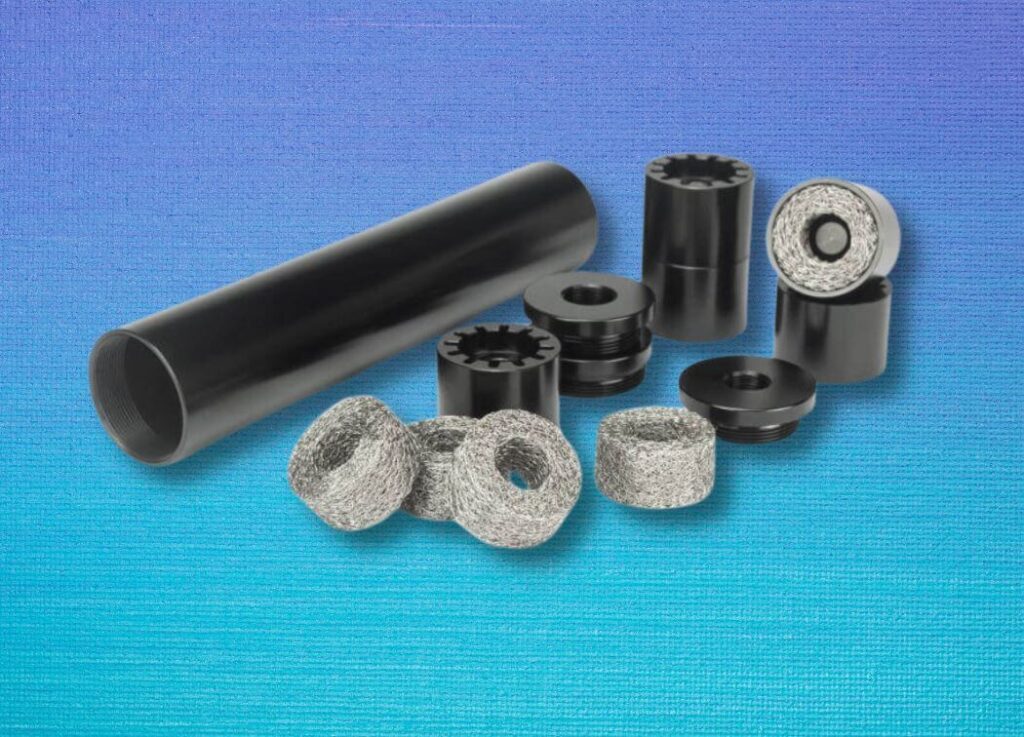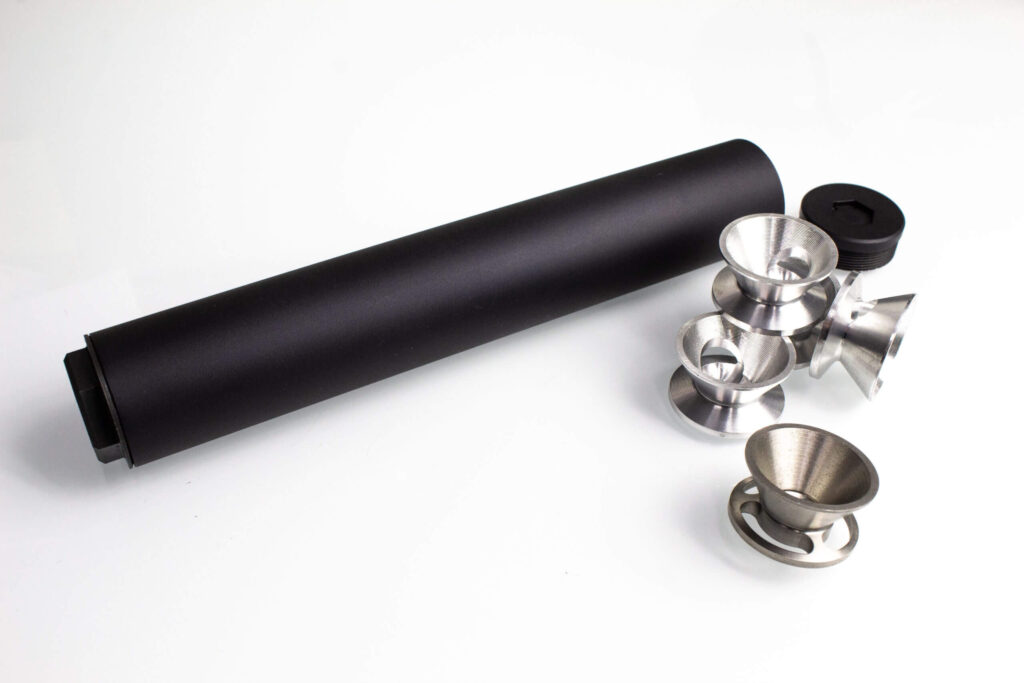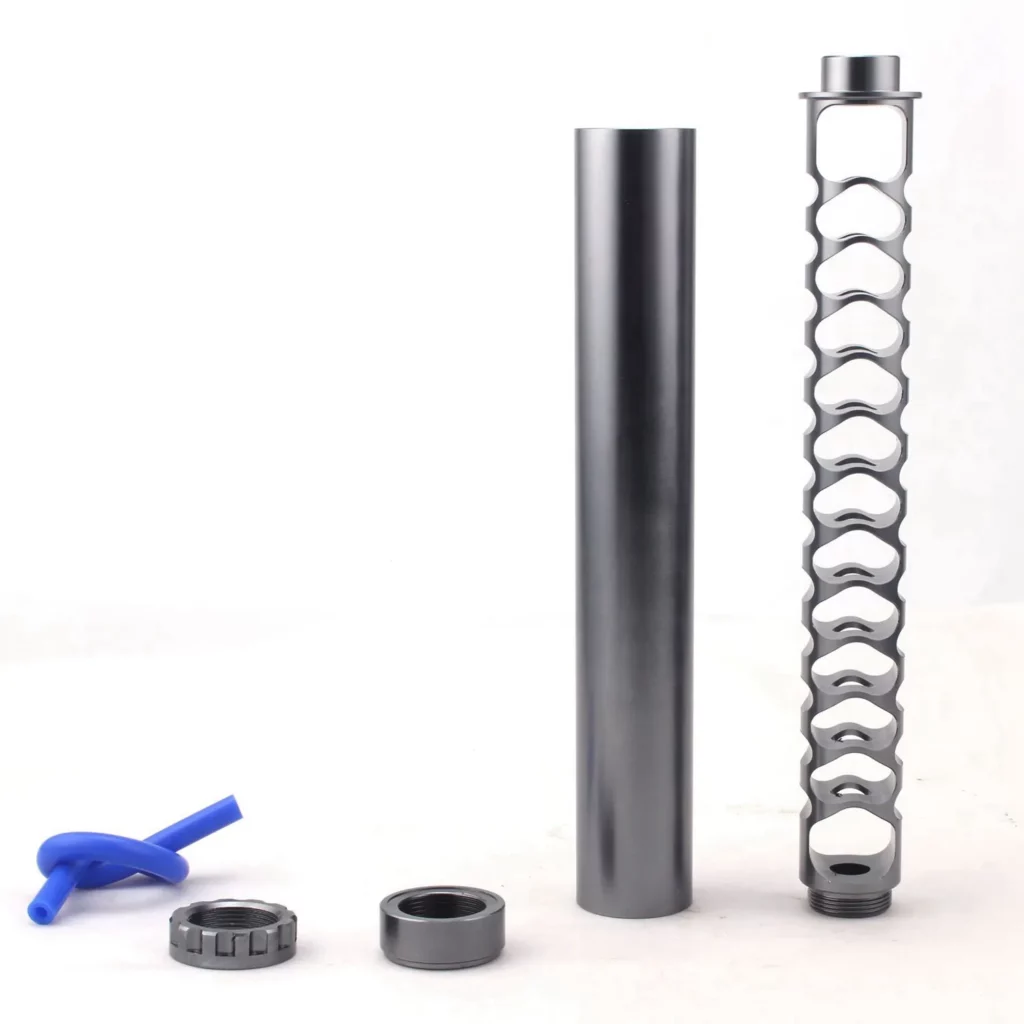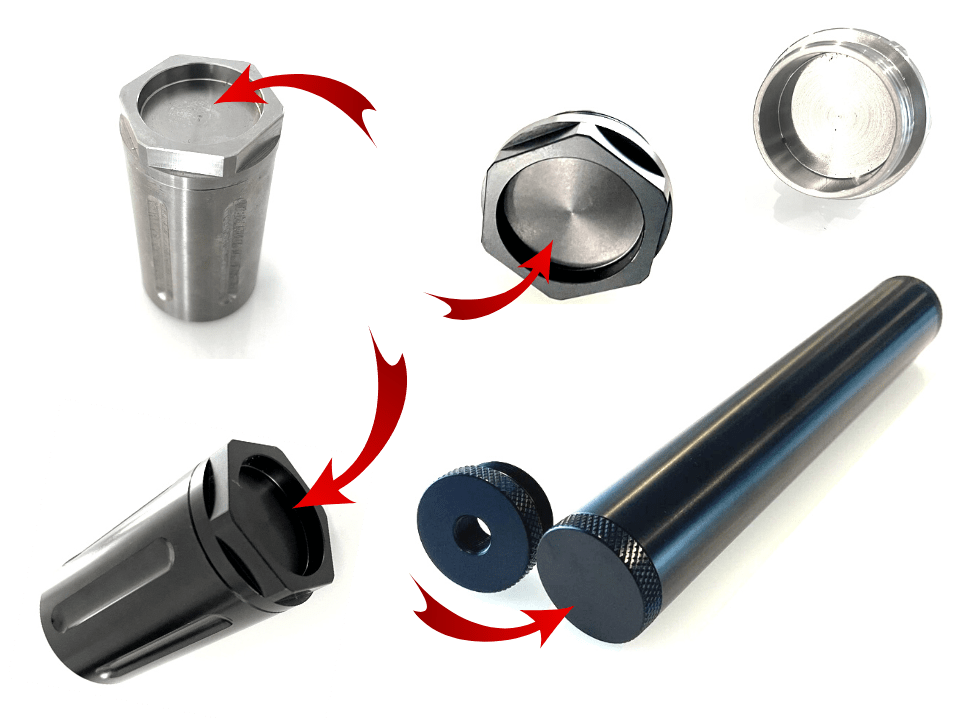Table of Contents
Steel solvent traps are devices designed for the purpose of capturing and containing solvent residue generated during firearm cleaning. They are commonly used by gun enthusiasts, professionals, and hobbyists to aid in the cleaning process while minimizing environmental impact.
The primary function of a steel solvent trap is to trap and collect solvent, preventing it from being released into the surroundings. Typically constructed with high-quality steel materials, these traps feature a series of baffles or filters that allow the solvent to pass through while capturing debris, particles, and contaminants. By effectively trapping these impurities, steel solvent traps help maintain the cleanliness and longevity of firearms.
Furthermore, steel solvent traps often serve as effective muzzle devices, reducing recoil and improving the overall shooting experience. They can be easily attached to the barrel of a firearm, providing stability and enhancing accuracy.
However, it is important to note that the use of solvent traps in some jurisdictions may be subject to specific regulations and legal considerations. Therefore, it is crucial to familiarize oneself with local laws and guidelines to ensure compliance and responsible usage.
Consumer Alert: Solvent Trap Market Advisory

Consumer Warning: Beware of Deceptive Practices in the Solvent Trap Market
When searching for solvent traps, it is important to exercise caution as some websites may mislead customers by linking to overseas companies that offer substandard or illegal products disguised as solvent trap kits. Be particularly cautious of links that redirect you to third-party sites, as they may be selling illegal items like the ‘monocoque’, falsely labeled as solvent traps, or even using terms like “fuel filter”. Remember that the ATF (Bureau of Alcohol, Tobacco, Firearms and Explosives) does not consider what the overseas manufacturer calls it, but rather holds the individual purchaser accountable.
Before making any purchases from overseas websites, think twice, as providing your shipping address or P.O. Box to order these illegal products could have serious consequences. Seizure at customs may result in felony charges, and you could receive a notice from the ATF regarding the situation. Avoid dealing with counterfeiters and refrain from purchasing solvent traps diluted with cheaper metal composites.
At Solvent Trap Depot, we take pride in offering legally compliant solvent trap cleaning kits and dry storage solutions. We do not sell illegal solvent traps or any items falsely labeled as such, including monocoque products or those with index marks. All of our Products are shipped From the U.S. It’s worth noting that some websites may display product images without apparent index marks but still, ship center-marked or indexed items, especially among overseas companies claiming to be US-based.
In the context of piping, an index mark and a lathe mark have different meanings:
– Indexing: Refers to the adjustment of products through indexation.
– Lathe Mark: Occurs naturally during the manufacturing process and is commonly found on end caps sold with tubes or pipes across various industries. These marks are caused by cutting or machining processes used to shape the part, leaving small impressions or circular marks. Lathe marks can vary in size but are typically small and barely visible, if present at all.
It is important to note that a wide range of end caps with and without small lathe marks are sold by numerous online businesses in various industries, including landscaping, irrigation, plumbing, home improvement, construction, storage tube and container solutions, and more.
Regarding Solvent Traps in Relation to Final Rule 2021R-05F

At Solvent Trap Depot, we have always sold our products without index marks. Our solvent traps are designed for their intended use of trapping solvent and are also available for purchase as dry storage solutions. No modifications are necessary to use them as intended.
The final rule primarily focuses on frames, receivers, firearm parts, and kit parts. However, the brief mention of “solvent traps” in the rule has directly impacted our business. It’s important to note that solvent traps are still considered firearm accessories and can still be effectively used for dry storage, offering dual functionality at an affordable price.
We want to clarify that Armory Den does not sell so-called “solvent traps” or “auto oil filter solvent traps.” Additionally, we do not sell frames, receivers, or firearm parts kits. While we are not legal experts in firearms or firearm kits, it is apparent that the rule’s vague nature leaves room for interpretation and potential NFA violations within the firearms industry.
Due to the impact of this rule and limited resources and time for support, we plan to introduce a completely new line of cleaning and dry storage products by 2024. We strive to operate our company legally and responsibly and do not sell NFA items. If necessary, we will consult with attorneys to address any concerns about our products with the DOJ or ATF.
We urge customers to conduct thorough research when shopping for firearm cleaning solutions, even for dry storage purposes. Always ensure you are purchasing from a legitimate US-based company. We have provided informative videos showcasing how our safe and eco-friendly cleaning and dry storage products are used. Rest assured, our solvent trap and dry storage solutions, along with their associated parts and accessories, comply with clear legal parameters and established guidelines.
Navigating the Regulatory Landscape of Steel Solvent Traps
It is crucial to understand that the purchase of a solvent trap is legal without the need for Form 1. However, some essential restrictions and regulations must be taken into account before buying these products. One crucial restriction is that you cannot alter, modify, or redesign a solvent trap to function as a device for muffling, silencing, or reducing the sound of a firearm. To do so, you must file Form 1 with the BATFE (Bureau of Alcohol, Tobacco, Firearms, and Explosives) and receive an approved stamp.
It is of utmost importance to be fully aware of the restrictions and regulations that apply, particularly within the state where you reside. Only after obtaining the approved Form 1 and paid tax stamp can you legally proceed with any modifications to the product. Engaging in alterations or modifications before receiving the approved Form 1 is a criminal offense.
Please be advised: Making any changes or modifications to our products, as well as any solvent trap product or part, before obtaining the approved Form 1 is considered a felony. To gain further understanding, we encourage you to review the information available in our ATF Legal Den and familiarize yourself with our website’s terms and conditions.
How Solvent Traps Work

Solvent traps work by capturing and containing solvent residue that is generated during the process of cleaning firearms. They are typically cylindrical devices, often made of materials such as steel or aluminum, and are designed to attach to the muzzle end of a firearm.
When using a solvent trap, the muzzle of the firearm is inserted into the trap, allowing the solvent to flow through the trap’s internal structure. The trap is equipped with various baffles, filters, or cups that serve to separate and collect the solvent residue. These components are designed to allow the solvent to pass through while trapping debris, particles, and contaminants.
As the solvent travels through the trap, it undergoes a process of filtration. The baffles or cups within the trap help to slow down and redirect the flow of the solvent, allowing time for the solvent to separate from the contaminants. This helps to ensure that the solvent collected in the trap is relatively clean and can be safely disposed of later.
Solvent traps are primarily used to prevent solvent residue from being released into the environment during the cleaning process. They help to maintain a cleaner workspace and reduce the potential impact on the surrounding area. Additionally, some solvent traps can also act as muzzle devices, reducing recoil and improving the overall shooting experience.
It’s important to note that while solvent traps are commonly used for cleaning firearms, they should not be modified or used as sound suppressors or silencers without proper legal authorization from the relevant authorities.
Best Material for Solvent Trap ( What We Recommend at solvent trap depot)
The best material for solvent traps depends on various factors, including durability, effectiveness, and legal considerations. Two commonly used materials for solvent traps are steel and aluminum.
1. Steelness Steel:
Steel solvent traps are known for their durability and longevity. They can withstand high temperatures and are less prone to deformation or damage. Steel traps are typically made from high-quality stainless steel, which offers excellent corrosion resistance. This makes steel solvent traps suitable for prolonged and heavy-duty use. However, it’s important to ensure compliance with legal requirements, as some jurisdictions have specific regulations regarding the use of steel solvent traps.
Stainless steel solvent traps are a popular choice among firearm enthusiasts for their durability, corrosion resistance, and overall performance. Here are some key features of stainless steel solvent traps:
1. Durability: Stainless steel is known for its exceptional durability and strength. Solvent traps made from stainless steel can withstand rigorous use and handling without easily deforming or breaking. This makes them suitable for long-term use and repeated cleaning sessions.
2. Corrosion Resistance: Stainless steel exhibits excellent resistance to corrosion and rust, even when exposed to moisture or harsh cleaning chemicals. This ensures that the solvent trap remains in good condition and maintains its performance over time.
3. Heat Resistance: Stainless steel can handle high temperatures without losing its structural integrity. This is especially important during intense cleaning processes that involve hot solvents or prolonged exposure to heat.
4. Easy Maintenance: Stainless steel solvent traps are relatively easy to clean and maintain. They can be easily wiped down or rinsed after use, and their corrosion-resistant properties help prevent the buildup of residue or contaminants.
Stainless steel solvent traps are available in various designs and configurations to accommodate different firearms and cleaning needs. When purchasing a stainless steel solvent trap, consider factors such as size, thread compatibility, and additional features that may enhance your cleaning experience.
2. Aluminum:
Aluminum solvent traps are lightweight and offer good resistance to corrosion. They are easier to handle and maneuver during the cleaning process. Aluminum traps are generally more affordable than steel traps, making them a popular choice among firearm enthusiasts. However, they may not be as durable as steel traps and can be more susceptible to wear and tear over time.
Aluminum solvent traps are a popular choice for firearm enthusiasts due to their lightweight nature and affordability. Here are some key features of aluminum solvent traps:
1. Lightweight: Aluminum is significantly lighter than materials like steel or titanium, making aluminum solvent traps easy to handle and maneuver during the cleaning process. The reduced weight also minimizes the additional weight added to the firearm.
2. Corrosion Resistance: Aluminum solvent traps are generally resistant to corrosion. Many aluminum traps undergo surface treatments or coatings to enhance their corrosion resistance and ensure long-term durability. However, it’s important to note that aluminum is not as corrosion-resistant as stainless steel or titanium.
3. Affordability: Aluminum solvent traps are often more cost-effective compared to stainless steel or titanium traps. This makes them a popular choice for those looking for a budget-friendly option without compromising on functionality.
4. Heat Dissipation: Aluminum has good thermal conductivity, allowing it to dissipate heat efficiently. This feature helps prevent the solvent trap from becoming excessively hot during extended cleaning sessions.
5. Maintenance: Aluminum solvent traps are relatively easy to clean and maintain. They can be wiped down or rinsed after use to remove residue and contaminants. However, it’s important to handle them carefully to avoid any potential damage or deformation.
3. Titanium
Titanium solvent traps are an alternative option for firearm enthusiasts looking for a material with specific advantages. Here are some key points about titanium solvent traps:
1. Lightweight: Titanium is known for its exceptional strength-to-weight ratio, making titanium solvent traps significantly lighter than their steel or aluminum counterparts. This makes them easier to handle and reduces the overall weight added to the firearm during cleaning.
2. High Strength: Titanium is a durable material that offers excellent strength and resistance to deformation. This allows titanium solvent traps to withstand rigorous use and maintain their shape even under high temperatures and pressures.
3. Corrosion Resistance: Titanium exhibits remarkable resistance to corrosion, even in harsh environments. This makes titanium solvent traps highly resistant to rust and degradation, ensuring long-term reliability.
4. Heat Dissipation: Titanium has excellent thermal conductivity, which allows it to dissipate heat more effectively than other materials. This can be beneficial during extended cleaning sessions, as it helps prevent the solvent trap from becoming excessively hot.
It’s worth mentioning that titanium solvent traps may come at a higher cost compared to steel or aluminum traps due to the higher material cost and manufacturing complexity. Consider your specific needs, budget, and legal requirements before deciding on a titanium solvent trap.
1/2-28 vs 5/8-24 Solvent trap

When it comes to choosing between a 5/8-24 solvent trap and a 1/2-28 solvent trap, it’s a decision that often reflects my personal firearm preferences and needs.
For me, the thread size choice depends on the specific firearms I own or plan to use the solvent trap with. If I primarily use firearms chambered in larger calibers like .308 or 7.62mm, I tend to lean towards the 5/8-24 thread size. It’s a common thread size for these calibers, and it ensures a secure and proper fit with my firearms. Plus, the larger diameter of the 5/8-24 thread provides a robust connection, giving me peace of mind during cleaning sessions.
On the other hand, if I mainly use firearms chambered in smaller calibers like .223 or 5.56mm, I opt for the 1/2-28 thread size. This thread size is more prevalent in firearms chambered in these calibers, making it easier to find compatible muzzle devices or barrels. The 1/2-28 thread size offers a secure fit and allows me to effectively clean my smaller caliber firearms.
Of course, if my firearms have different thread sizes than the available solvent traps, I make sure to use appropriate adapters to bridge the gap. Adapters provide versatility and allow me to use a wider range of solvent traps with my firearms.
Overall, the choice between a 5/8-24 and 1/2-28 solvent trap is a personal one, influenced by the firearms I own and my specific cleaning requirements. It’s essential to research and ensure thread size compatibility to maximize the effectiveness and convenience of the solvent trap during my cleaning routine.
What are the Solvent Trap Parts

Solvent trap parts are essential components that make up a solvent trap system used for firearm cleaning. Understanding the different parts can help you assemble and customize your solvent trap according to your specific needs. Here are some common solvent trap parts:
1. Tube: The tube is the main body of the solvent trap. It is typically cylindrical and made of materials like aluminum, stainless steel, or titanium. The tube provides the structure and containment for the solvent and debris during the cleaning process.
2. End Caps: End caps are attached to each end of the tube and serve as closure points. They are available in various designs and can have features such as threaded holes for attachments or knurled surfaces for easy gripping during assembly or disassembly.
3. Baffles/Cups: Baffles, also known as cups, are internal components that help trap and filter debris and solvent during the cleaning process. They are often stacked inside the tube and can be made of materials like aluminum, stainless steel, or even polymer. Baffles come in different shapes and designs to optimize solvent flow and filtration.
4. Threaded Adapters: Threaded adapters allow for proper attachment of the solvent trap to the barrel or muzzle device of a firearm. They bridge the gap between different thread sizes, ensuring a secure and snug fit.
5. Mounting Options: Some solvent trap systems offer mounting options for added convenience. This can include direct thread mounts, quick-detach (QD) mounts, or other attachment mechanisms to connect the solvent trap to the firearm securely.
6. Storage Cups: Optional storage cups can be used within the solvent trap system for additional purposes. These cups provide dry storage compartments to keep small items like spare parts, cleaning patches, or other accessories safely stored.
It’s important to note that while solvent trap parts are commonly used for firearm cleaning, modifying them into a suppressor without proper legal authorization is illegal in many jurisdictions. Always ensure compliance with local laws and regulations regarding solvent traps and NFA (National Firearms Act) regulations.
When selecting solvent trap parts, prioritize quality, compatibility, and reliability. Choose reputable manufacturers or suppliers who offer high-quality components that meet your specific requirements. Following proper assembly guidelines and maintenance practices will ensure a safe and effective cleaning experience for your firearms.
Why Buy From us
we take pride in offering a wide range of solvent traps for sale. Our solvent traps are designed to assist you in the process of firearm cleaning by effectively trapping solvents and debris. We strive to provide high-quality products that meet your cleaning needs.
Our selection includes various materials, sizes, and configurations to cater to different firearms and cleaning preferences. Whether you’re looking for stainless steel, titanium, or aluminum solvent traps, we have options available to suit your requirements.
We understand the importance of customer privacy and discreet packaging. When you place an order with us, we ensure that your purchase is packaged securely and discreetly, protecting your privacy throughout the shipping process.
Our team is committed to providing excellent customer service and support. If you have any questions about our solvent traps or need assistance in choosing the right product for your firearm, our knowledgeable staff is here to help. We aim to make your shopping experience smooth and enjoyable. Visit our shop

